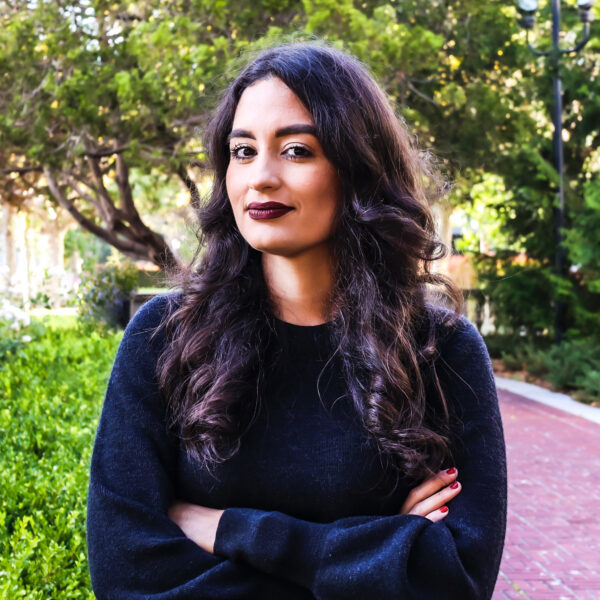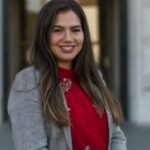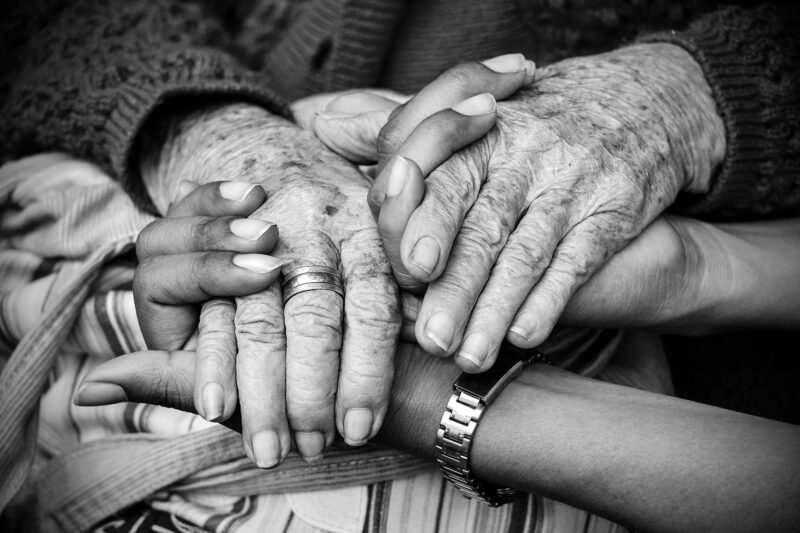Americans are aging, but the experience of retiring is far from equitable. The dream of an adequate pension or retirement fund, and of residing in an age-friendly community, seems increasingly inaccessible for many historically marginalized older Americans. What does aging look like across the spectrum of older Americans, and what does it specifically look like for Latinx older adults?
For this Q&A, Julia Sizek, Matrix Content Curator and a PhD Candidate in the UC Berkeley Department of Anthropology, spoke with two graduate students from UC Berkeley — Isabel García Valdivia and Melanie Z. Plasencia — whose research examines what aging looks like for the Latinx communities in the United States, particularly in California, Mexico, and New Jersey.

Isabel García Valdivia is a PhD candidate in the UC Berkeley Department of Sociology whose research focuses on the life course of Latinx immigrants and their families in the United States, focused on California and Mexico. Her 2020 paper, “Legal Power in Action: How Latinx Adult Children Mitigate the Effects of Parents’ Legal Status through Brokering,”published in Social Problems, received student paper awards from the American Sociological Association’s Latino/a Sociology Section and the Society for the Study for Social Problems’ Youth, Aging, and the Life Course division. The paper discusses how children of immigrant parents broker, or liaise, on behalf of their parents, and how citizenship status affects their success in navigating legal and financial institutions.

Melanie Z. Plasencia is a PhD candidate in the UC Berkeley Department of Ethnic Studies who examines the role of social support and place in shaping the health and well-being of older Latinx people, in order to improve older immigrants’ social, economic, and health conditions. Her research on how older Latinxs envision an age-friendly environment was published in The Gerontologist: “Age-friendly as Tranquilo Ambiente: How Socio-Cultural Perspectives Shape the Lived Environment of Latinx Older Adults argues that social and cultural elements must be considered when constructing “age-friendly” communities for older Latinxs. A second publication, “‘I don’t have much money, but I have a lot of friends’: How Poor Older Latinxs Find Tangible Support in Peer Friendship Networks,” will be published in Social Problems and was awarded Second Place in the Emerging Scholars Poster Competition at the International Conference on Aging in the Americas (ICAA) in 2017. This article demonstrates how older Latinx peer networks are an important source of support, as they take into consideration the limitations of the aging body and affirm their intersectional identities as Latinxs, as immigrants, and as older adults in the United States. Her research has been supported by the Ford Foundation and Dartmouth College, where she resides as the 2021-2022 César Chávez Predoctoral Fellow. She is also presently the student representative for the ASA section on Aging and the Lifecourse.
Q: How did you decide that aging is an important part of the immigrant experience, and that you wanted to study this particular lifestage?
Melanie: I have both a personal and academic investment in the fields of race, ethnicity, and aging. I was raised by my grandmother and her group of friends, who were foreign-born immigrants from Latin America and the Hispanic-Caribbean. Witnessing my grandmother’s and her friends’ experiences as older persons really clued me into the realities that older adults face, and some of the ways that we can better support them.
However, it wasn’t until college that my mentor, Professor Ulla Berg, recommended that I turn my personal interest in aging into academic study. Since then, I have been focused on understanding the experiences of older foreign-born Latinxs and how they adapt to growing old in the U.S., especially under extreme duress and hardship. From my research, I’ve uncovered significant needs within the older Latinx population that researchers should pay closer attention to. A majority of older Latinxs worked in jobs that did not afford them an adequate pension or retirement. If they do qualify for federal aid, it is often a very small amount that does not meet their basic standards of living, especially in areas where gentrification is presently taking place and housing and other basic necessities are continually on the rise. It has been reported that 42% of married couples and 59% of unmarried older Latinxs relied on federal aid for more than 90% of their income to survive (Social Security Administration 2017), but this does not capture the experiences of those who do not qualify for institutional support. The number of older undocumented Latinxs is expected to increase in the next 20 years, and this population will be in need of health insurance and other modes of support for their survival as well (Ro, Hook and Walsermann 2021). (The Elder Index is a helpful tool to learn more about what older adults would need to cover housing, healthcare, transportation, food and other miscellaneous items in different geographical areas across the U.S.)
Isabel: Similar to Melanie, I have an academic and personal interest in learning more about the aging process of Latinx communities. In particular, I am interested in learning how the racialized United States immigration regime impacts immigrants’ lives across the life course. My academic interest in studying Latinx aging experiences stems from interviews with past research participants. In some of my research, I work with mixed-status families, whose members include a combination of legal statuses; specifically, I refer to the subset of families with at least one undocumented member. In my study, parents I interviewed expressed their concerns about accessing critical support like healthcare and financial security as they aged without an immigration status. Individuals need an immigration status to access federally funded safety nets. Similarly, their adult children highlighted how they expect to take care of their undocumented aging immigrant parents with little support from traditional safety nets, such as Medicare and Social Security.
A little-known fact is that immigrants, including undocumented immigrants, were not always barred from safety nets due to their immigration status. Undocumented immigrants began to be excluded from federally funded safety programs starting in the 1970s with the Old Age Assistance program, now known as Supplemental Security Income (Fox 2016). In recent years, access to safety nets has diminished for legal immigrants, too.
At a personal level, I am the daughter of immigrants and I feel responsible for reducing barriers for my parents and improving their aging experiences. They are still young, but they have worked physically and mentally straining jobs that impact their aging experience. This influences my interest in learning more about aging and the factors that impact immigrants’ experiences.
Q: Both of you spent significant time in the communities where you worked, conducting interviews and ethnographic research. Discuss what your research methods were, and how this kind of ethnographic attention differs from how aging is typically studied.
Melanie: Typically, research on older Latinxs has been quantitative, using rich datasets from population-based surveys that measure the health and well-being of older Hispanics/Latinxs, such as the Hispanic EPESE and the Health and Retirement Survey (HRS). However, as stated at a recent virtual talk by gerontologist Professor Deborah Carr, immigrants on average only make up about 15% of these analyses. Isabel and I are offering a qualitative examination that focuses specifically on older Latinx immigrants in the U.S. (in my case) and binationally, via Mexico and the U.S. (in the case of Isabel’s work).
Isabel: The EPESE and HRS are well-known as exceptional for understanding U.S. aging experiences, but they also have limits. For example, the HRS is nationally representative and oversamples the Latinx population, yet given the migration histories and patterns of different Latinx ethnic immigrant (or foreign-born) groups (e.g., Mexicans, Central Americans, Cubans, South America), the samples are still small. Many Latinx immigrants migrated to the United States after 1965, and these datasets are just starting to sample these cohorts. These older adult cohorts have also come to the U.S. in an era when greater restrictions have been imposed on immigrants’ access to safety nets.
Because the people I interview include undocumented older adults who may feel more vulnerable if they self-identify, trust is key. I conducted semi-structured, in-depth interviews with participants in California, and with migrants who have returned to Mexico. To create trust and to learn more about these communities, I had to build trust by volunteering at organizations at churches, and by making connections one-to-one with respondents. This meant showing up at their coffee meet-up locations where older adults gathered to drink coffee, socialize, and play games in a local store that provided outdoor tables, chairs, and benches and helping when asked to. It also gave me a lot of insights beyond what the research participants shared in the interviews. For example, I heard more stories about their day-to-day interactions with family members and struggles with bureaucracy. Since the initial interviews in spring/summer 2019, I have reinterviewed some of them, am still interviewing others, and some have reached out to check-in. It has been a very insightful experience.
Melanie: My work differs from how research on aging typically has been studied in a few different ways. I use my interdisciplinary training to conduct research that uses an intersectional approach. For example, key considerations for my research are the role of race, ethnicity, gender, class, immigration status, and disability in relation to the lives of older Latinxs. I see my work as building critical connections across the fields of Latinx Studies, gerontology, and sociology. While Latinx Studies has called attention to the importance of community formation and pan-ethnicity among Latin American immigrants in the U.S., we know little about what community means for older Latinxs. In sociology, there is an emphasis on older adults and inequality, but the work on older Latinxs has been largely limited, and in gerontology there is increasing demand for more research on the needs and experiences of older immigrants broadly. I see myself as an interlocutor between fields and between the academic institution and community. My training in Ethnic Studies, for example, makes it so that much of my work is grounded in being among the community and learning from participants as collaborators, with collective goals to create better living environments for poor, historically marginalized older adults on their terms (for example, based on the concept of tranquilo ambiente, which I describe in my manuscript as a concept developed by my participants to describe what an age-friendly community should encompass), and to push for better local and federal solutions that improve their livelihoods as they grow older.
Q: How does immigrants’ legal status affect their ability to access social services and benefits as they age?
Isabel: It is complicated. In short, lacking an immigration status (i.e., being undocumented) bars immigrants from accessing most federally funded safety net programs. This is purposeful and is embedded in current immigration law. Exclusions also apply to legal migration. For example, at the time of applying for permanent legal residency, individuals (regardless of age) must provide an affidavit of financial support from a U.S. citizen or legal permanent resident (usually a family member or friend) to immigration officials and are barred from using federally funded safety nets for at least five years following their arrival in the United States.
However, given the distinction between federal, state, and local governments, some jurisdictions allow immigrants to access some forms of care and safety nets. For example, under its program Health Program of Alameda County (HealthPAC), California’s Alameda County provides affordable healthcare to low-income, uninsured people living in Alameda County, regardless of immigration status. This helps immigrants of all ages, including older adult immigrants.
The main institutions of support for older adults are Social Security and Medicare, which are federally managed and are essential sources of support for aging low-income workers. Undocumented immigrants are ineligible for most federal public benefits, including Medicare and Social Security.
Melanie: Isabel’s description is spot on. It is complicated both federally, but also by each state. In New Jersey, undocumented immigrants use Charity Care, which is also for low-income and uninsured people. However, Charity Care might not cover all of their medical services and needs. For example, one undocumented woman I interviewed had become deaf in one ear and was in need of $850 dollars to complete the purchase of a hearing device, which was not entirely covered by Charity Care. The undocumented older adults that I interviewed or spent time with during my ethnographic work had to rely on family and friends for economic support for their daily survival. Undocumented older adults often used their networks to find employment, to ask for a loan of money, or to even ask for a collection on their behalf when times were extremely difficult. It was also common to hear older undocumented immigrants express that they were having a hard time finding work because of their status and their age. Many faced age discrimination, which added an additional layer of precarity that they had to navigate on a daily basis.
Q: As both of you note in your research, older Latinxs have among the highest rates of poverty in the United States, and their economic status shapes how they and their families can access social services. How do you account for these economic determinants in your research in comparison to other factors, like citizenship status? What do they explain, and what can they not explain?
Isabel: Economic and citizenship status are interrelated in my work. The current immigration system stratifies the lifelong economic opportunities of immigrants. It starts with, how did the immigrants arrive with or without visas? From where did they arrive, and were they with family, immigrant-friendly communities, or neither? What opportunities were available to them? What types of employment opportunities were available? How have they been integrated (or not) into U.S. society? Do they have language barriers? I try to understand immigrants’ experiences through a life-course perspective because context really matters.
We must be cautious about looking solely at economic factors because they do not take historical context into account. For Mexicans, there is a long history of using workers as cheap disposable labor, for example through the Bracero Program, a federal temporary guest worker program that allowed Mexican men to come to the U.S. to work mostly in low-paying agriculture jobs. When the Bracero Program ended, many men continued to return to the U.S., and sometimes their offspring did, too. In 1986, many agricultural workers adjusted their immigration status with amnesty through the Immigration Reform and Control Act, or IRCA. This was the last and only large-scale legalization program. In the life trajectories of many of the older adults I interview, I see how these historical events and programs shaped their lives.
Melanie: I agree with Isabel that context matters, and several social, economic, and political factors influence the life-course trajectories of older Latinx immigrants. In my own work, I was inspired by my upbringing to consider how older Latinxs survive with limited economic means, and that became the impetus for my larger dissertation study on how they adapt and adjust to growing old in the U.S., by observing the role of the family, community, and place. I would say that economic factors are interrelated with other factors, including the social determinants of health. With limited means, they have poorer chances of surviving with a high quality of life.
Another example of how historical context, migration, economics, and health converge can be seen in the case of older Puerto Ricans. As a colony of the U.S., Puerto Ricans who remain on the island have been relegated to second-class citizenship status, which does not permit them the same rights as other U.S. citizens, such as the right to vote for the U.S. president in primary elections. In Puerto Rico itself, there is increasing financial debt, governmental mismanagement, and the historical legacy of several policies that have stripped the island of its independence. These conditions have led to a large out-migration of both young and middle-aged Puerto Ricans and has increased population aging on the island (Abel and Deitz 2014).
Presently, the island is facing a “parallel pandemic” as a result of poverty and inequality, the COVID-19 pandemic, and recent hurricanes (García et al. 2021). These compounding disasters (see Garriga‐López) have furthered health disparities among Puerto Ricans, such as the older adult population, who were already suffering at high rates from several chronic conditions, including diabetes and hypertension (García et al. 2021). Island-born Puerto Ricans residing in the U.S. have also been shown to have worse health compared to other Latinxs and non-Latinx whites (Pérez and Ailshire 2017).
Q: Isabel, your research emphasizes the intergenerational aspects of aging. How are families affected by the aging of the older generations?
Isabel: Broadly speaking, their lives are linked. I see how immigration status stratifies the experiences of both older adults and their adult children. For example, I see how adult children take on more of the care and costs of their aging parents, who do not have access to safety nets. This contrasts with research on poor, aging citizens who still have access to basic safety nets and whose children may provide support after they exhaust all other sources. Providing support to aging parents is especially difficult for low- and middle-income families in areas with high cost of living, like the San Francisco Bay Area. High costs are also forcing their children to move farther away from them, as Melanie’s work also shows. The lack of support not only affects older adults, but also their adult children and grandchildren. Their lives are intricately linked.
Q: Melanie, your forthcoming piece in Social Problems discusses the evolving role of family and how we must also consider the role of friends in the lives of older Latinx people. What support do friends provide that might make them as important as that offered by family members?
Melanie: We know from the literature on Latinx populations and immigration that family can be tenuous due to one’s social conditions, expectations, and needs. In my research, I found that older Latinxs spent considerable time with friends, especially when family was not available due to a variety of factors, such as their children being incarcerated or sick or having children of their own to care for. They may also turn to friends when their children move to the suburbs and attain some level of upward mobility, as they may not want to live with them or be seen as a burden. There were several dynamics at play that made friends an easier avenue for support.
I wanted to shift the conversation by offering another lens to view older Latinx care. I argue in the piece that friends or peer networks have the ability to support older Latinxs by providing them with social, economic, and emotional support that other networks may not be able to provide, since they are removed from some of the conditions affecting them as older Latinxs. For example, peers have the unique ability to understand each other’s migration experiences, the challenges that they have faced while adapting to the U.S., and also the challenges they face in the present as they grow old, such as understanding medical and health services and institutions and planning for later life. I wrote this paper on peer networks as a way to consider another avenue that can offer support to older Latinxs, and to consider how we could collectively infuse these networks at the community-level.
Q: While you both work on similar topics, your research takes place across different coasts. How do the histories of the places where you work — the East Bay of San Francisco and New Jersey — shape the possibilities for the Latinx people who are aging there? What are some of the consequential differences between your fieldsites?
Melanie: The location of my fieldsite is Hudson County, New Jersey, relatively close to New York City, near the Lincoln Tunnel that goes into Times Square. One of the reasons I was drawn to my fieldsite is because, often in Latinx Studies, we focus on three dominant geographies for Latinx life — New York, Los Angeles, and Texas — but now more than ever, Latinxs are moving beyond these epicenters into new areas and creating communities and enclaves that support their survival.
In the case of Hudson County, people forget about its close proximity to Manhattan and how that has played a role in the creation of the community as a Latinx enclave. Many of the older Latinxs from my study actually arrived in New York City to work as domestic or factory workers, but found their way across the Hudson due to informal networks and a lower cost of living.
My dissertation, Con Suenos Que Ya Son Viejos [With Dreams That Are Already Old], focuses on the older Latinxs who arrived in the U.S. to make money and planned to one day return home, but due to a series of circumstances have lived out their remaining years here in the U.S. Many of them are what Brian Hofland and Fernando M. Torres-Gil describe as “stuck in place,” a gerontological term that discusses how some historically marginalized older adults do not have the choice to grow old where they want. I would argue that some also decide to stay in place because they value the social and cultural aspects of the enclave. Here they can more readily find support, such as emergency assistance and food and furniture referrals, and it is easier to find facilities that accept Charity Care from uninsured patients. However, more research is needed to examine how state and federal governments provide limited assistance to care, which can make obtaining support to navigate older adulthood precarious, stressful, and expensive.
Isabel: Melanie is correct that Latinx populations are moving beyond the traditional locations. My dissertation work, Becoming Invisible: Aging and Stratification for Older Immigrants in the United States and Mexico, takes place in California, a traditional immigrant receiving state, and the East Bay. Many of the older Mexican immigrants that I interviewed moved to the East Bay due to family connections. Some had parents or other family members who were part of the Bracero Program, while others used established social networks from their hometowns or rural areas to move to the area. Return migrants I interviewed in Mexico were from Jalisco, a traditional sending Mexican state that has a long history of migration to California. I selected these sites because there are many studies with the Mexican-origin population that assume that older adults return to Mexico to retire. Thus, my binational approach sought to compare the experiences of Mexican immigrants who are aging in the U.S. and those who opted out.
California and the East Bay are immigrant-friendly geographic locations and have deeply shaped how low-income older adults access low-cost health care and housing subsidies. California is shaping immigrant-friendly progressive policies. For example, the state of California has just approved the expansion of medical health coverage to all low-income adults over 50 (regardless of immigration status) starting in May 2022. Meanwhile, the returnees I spoke to in Mexico often have a legal immigration status that allowed them to gain capital, or accumulated wealth, or social benefits (e.g., Social Security). They are also able to return to the U.S. if they desire, and their retirement income goes a long way in Mexico where their cost of living is often lower.
Q: How has the pandemic reshaped your research?
Melanie: The pandemic has raised questions about structural discrimination and its effects on older minority populations, and has brought to the fore the highly unequal environments that Latinx older adults face. For example, a recent study has shown that Black and Latinx older adults face an accumulation of disadvantages across the life course that makes them more susceptible to contracting and having health complications from sicknesses like COVID-19 (Garcia et. al 2021). I am working on an epilogue to my dissertation that looks at how social distancing mandated by COVID-19 mitigation measures have impacted and possibly undermined the rich networks that existed for older Latinxs in my fieldsite. My sense is that older Latinxs in the community I study felt supported during the quarantine, based on the ease of partaking in alternative forms of their daily activities and the care and concern provided by the community. For example, critical cultural resources evolved: churches shifted to online platforms, many older adults used phone chains to pray and stay in touch, and the city brought food and masks to older adults’ doors and provided rental assistance and socially distanced transportation to medical appointments. Together, communal care and daily activity helped to limit feelings of social isolation. However, I should also say that the use of this landscape differed remarkably by gender, immigration, and marriage status, which I plan to write about in an upcoming piece.
Isabel: I have maintained communication with the older adults in my research and begun reinterviewing them since the start of the COVID-19 pandemic. The experience of the pandemic for older adults was significantly shaped by their immigration status. Undocumented older adults were not able to access much of the federal stimulus. Grassroots funds emerged, as well as private and state support, that only some were able to access. However, it was difficult for many older adults to apply for these opportunities because of their lack of technological knowledge or understanding of whether they qualify. There was a lot of misinformation about the pandemic, and many feared being punished for accepting help. Prior to the pandemic, President Trump also sought to make it more difficult for undocumented immigrants to adjust their immigration status by changing the “public charge” requirements by amending the Department of Homeland Security’s (DHS) regulations on how DHS determined whether an immigrant applying for admission was likely to become a dependent on certain government benefits in the future, or “a public charge.” The revised regulations added Medicaid, Supplemental Nutrition Assistance Program (SNAP), Medicare Part D, and Housing Assistance to the benefits that must be considered for immigrant admission. This influenced older adult immigrants’ willingness to actively seek pandemic-related support, including healthcare.
Q: What has previous research by gerontologists and policymakers helped us understand about how aging is changing in the United States? How does this differ from what you’ve been finding in your research?
Isabel: Work by gerontologists and social scientists has begun to show demographically who the aging population is and how it will change. The next groups of older adults will be less white, more diverse, and the cohorts will have grown old under different policy conditions. This forecasts that their needs will be different. For example, immigration dramatically changed after the Immigration and Nationality Act of 1965, which imposed limits on immigration from nations in the western hemisphere for the first time, and after the exclusion of immigrants from social safety nets began in the 1970s.
Life course and aging theory show us how inequalities across an individual’s life shape their aging experience, and how policies further shape these inequalities. For example, laws that exclude immigrants from participating in formal employment also bar them from accessing important programs like Social Security and Medicare in late adulthood, even if they contribute to the fund. Federal funding often omits safety nets for undocumented individuals, even though many pay income taxes (as required by federal law). The intention of these restrictive immigration laws is to punish individuals, but we are really hurting their entire families (often citizens), who must carry the costs. It is critical to understand that every policy we enact has long-term consequences — everything from immigration to housing to social safety nets. We need to go no further than the Social Security Act to see how it helped decrease poverty among the elderly (even though it is not sufficient).
Melanie: As stated by Isabel, the general trend among gerontologists and policymakers has been to shift the conversation to “diverse aging,” which includes older Latinx immigrants, as well as other racial/ethnic populations, disabled older adults, and other historically marginalized populations, such as older LGBTQIA adults. My work is a continuation of the work of several scholars who have shifted the tides of gerontological work with important theories on race, ethnicity, gender, and class. Before I began my work, there were scholars who developed concepts like double jeopardy (Beale 1970, 2008), which became the impetus for studying the compounding effects of race, gender, and age. That was followed by triple jeopardy theory, which additionally considered sexuality as well as other categories of social stratification among older adults, and cumulative advantage/disadvantage theory, which focuses on the ways in which one’s early life, including advantages and privileges, or lack thereof, come to shape one’s life course into old age.
My work is different because I am working with a strong foundation from people before me, and because times have evolved, so much so that someone like myself who is a Latina, raised in a single-headed household and in a low-income area, can now complete a PhD at a place like UC Berkeley. I also benefit from having had the opportunity to work in a field that has afforded me an interdisciplinary range of ethnic and cultural studies courses, and has allowed me to take classes in public health, sociology, and social welfare. This combination informs my focus on ethnic aging and community, and also affects the policy interventions I am interested in highlighting in my work. As a result, I believe that aging equitably is part of meeting the challenge to live in a just world. This includes the incorporation of immigrants, as mentioned by Isabel, and also policies that focus on addressing affordable housing, food insecurity, healthcare needs, and policy interventions that address earlier determinants of one’s life chances, such as better working conditions, fair wages, and better education, to name a few. Once we address these and other social inequalities, we can see those fruitful changes at play at the end of the life course for everyone. Aging equitably can be our measure of success as a society.
References
Abel, J. R., & Deitz, R. (2014). The Causes and Consequences of Puerto Rico’s Declining Population (SSRN Scholarly Paper ID 2477891). Social Science Research Network. https://papers.ssrn.com/abstract=2477891
Beal, F. M. (2008). Double Jeopardy: To Be Black and Female. Meridians, 8(2), 166–176. https://doi.org/10.2979/MER.2008.8.2.166
Fox, Cybelle. (2016). “Unauthorized Welfare: The Origins of Immigrant Status Restrictions in American Social Policy.” Journal of American History 102(4):1051–74. doi: 10.1093/jahist/jav758.
García, C., Rivera, F. I., Garcia, M. A., Burgos, G., & Aranda, M. P. (2021). Contextualizing the COVID-19 Era in Puerto Rico: Compounding Disasters and Parallel Pandemics. The Journals of Gerontology: Series B, 76(7), e263–e267. https://doi.org/10.1093/geronb/gbaa186
Garcia, M. A., Homan, P. A., García, C., & Brown, T. H. (2021). The Color of COVID-19: Structural Racism and the Disproportionate Impact of the Pandemic on Older Black and Latinx Adults. The Journals of Gerontology: Series B, 76(3), e75–e80. https://doi.org/10.1093/geronb/gbaa114
Garriga‐López, A. M. (2020). Compounded disasters: Puerto Rico confronts COVID-19 under US colonialism. Social Anthropology / Anthropologie Sociale, 28(2), 269–270. https://doi.org/10.1111/1469-8676.12821
Pérez, C., & Ailshire, J. A. (2017). Aging in Puerto Rico: A Comparison of Health Status Among Island Puerto Rican and Mainland U.S. Older Adults. Journal of Aging and Health, 29(6), 1056–1078. https://doi.org/10.1177/0898264317714144
Plasencia, M. Z. (2021). Age-friendly as Tranquilo Ambiente: How Socio-Cultural Perspectives Shape the Lived Environment of Latinx Older Adults. The Gerontologist, gnab137. https://doi.org/10.1093/geront/gnab137
Ro, A., Van Hook, J., & Walsemann, K. M. (2021). Undocumented Older Latino Immigrants in the United States: Population Projections and Share of Older Undocumented Latinos by Health Insurance Coverage and Chronic Health Conditions, 2018–2038. The Journals of Gerontology: Series B, gbab189. https://doi.org/10.1093/geronb/gbab189
Social Security Administration. (n.d.). Hispanics’ Understanding of Social Security and the Implications for Retirement Security: A Qualitative Study. Social Security Administration Research, Statistics, and Policy Analysis. Retrieved November 24, 2021, from https://www.ssa.gov/policy/docs/ssb/v77n3/v77n3p1.html#mt9
Torres-Gil, F., & Hofland, B. (2012). Vulnerable Populations. In H. Cisneros, M. Dyer-Chamberlain, & J. Hickie (Eds.), Independent for Life: Homes and Neighborhoods for an Aging America. University of Texas Press.



